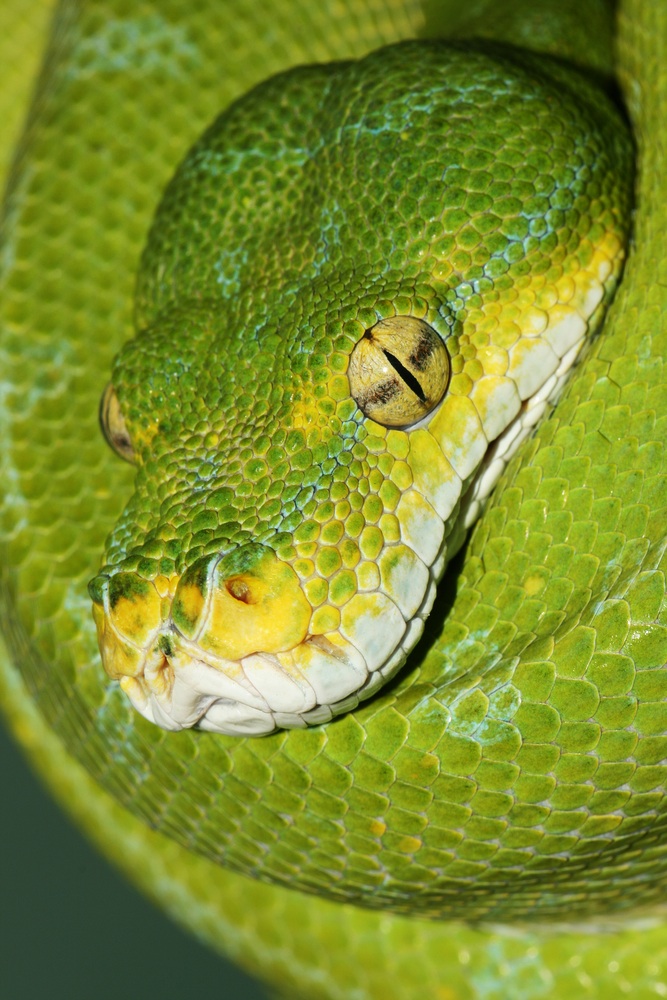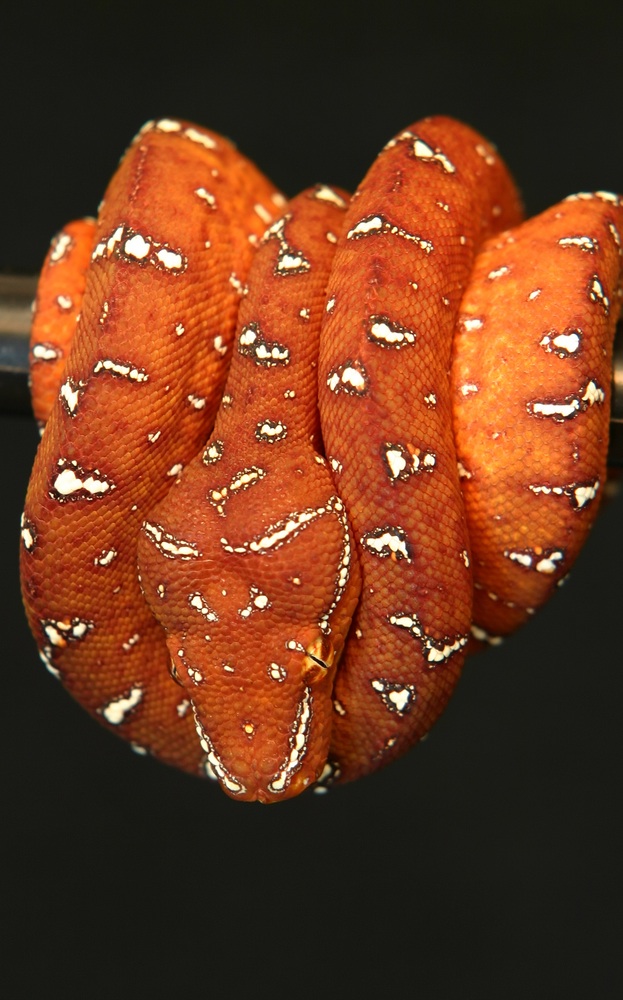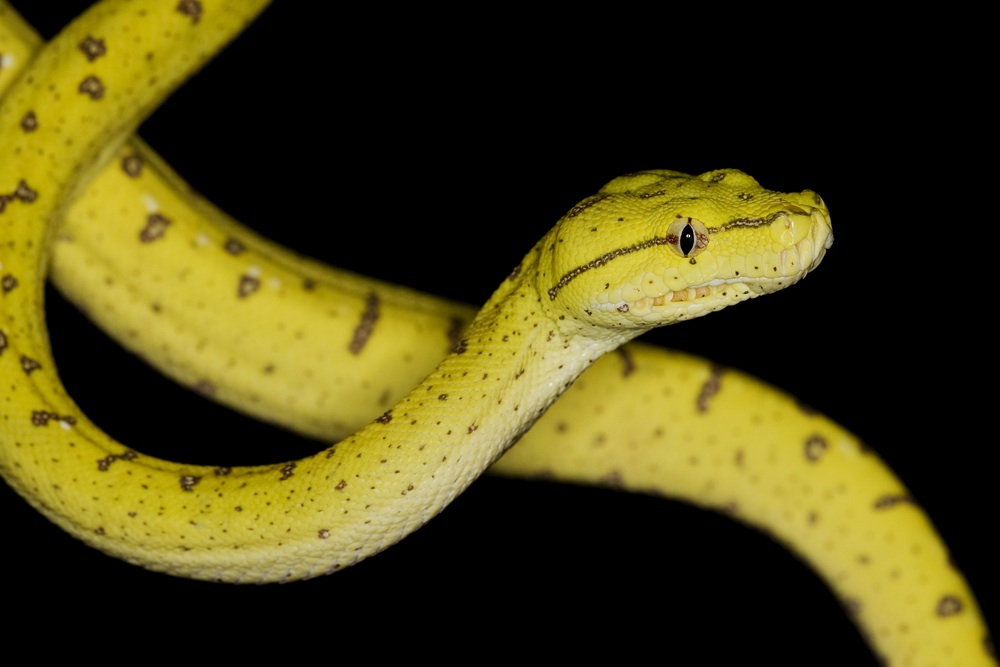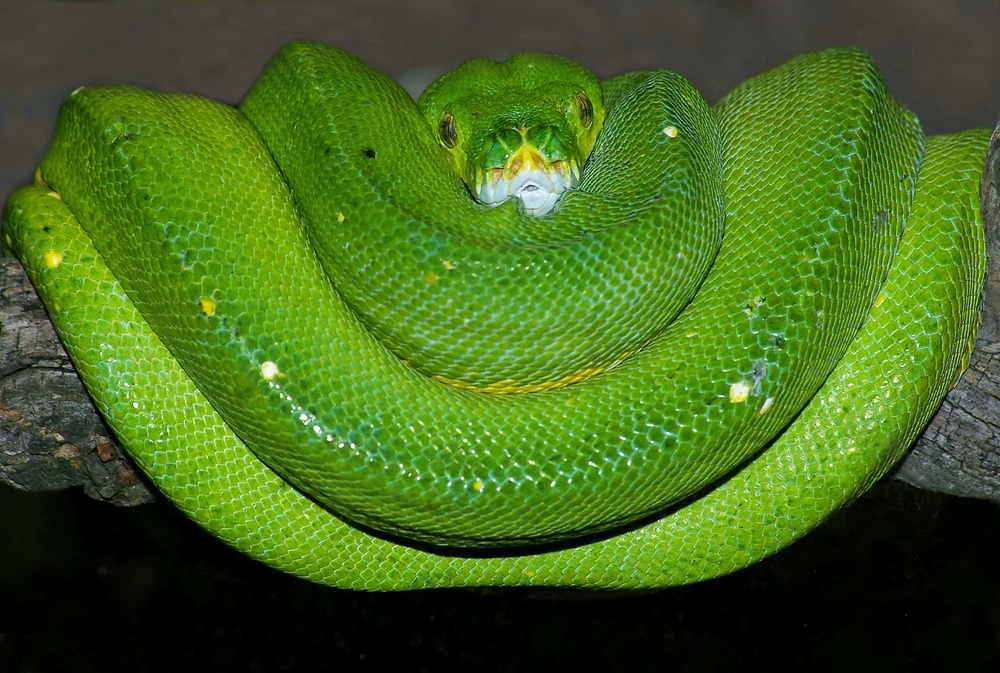Green Tree Pythons

Green tree pythons - or GTPs as they’re often described - rank amongst the most beautiful of all snakes, with their young undergoing a stunning transformation in coloration. Elegance is a word that comes to mind when describing GTPs. Yet their beauty masks their reputation for being rather feisty snakes, which do not appreciate being handled and will bite readily, if given the opportunity. They are also nocturnal by nature, hunting after dark, being able to locate prey thanks to the heat-seeking sensors around their jaws, and typically grow to about 1.2m (4ft) long.
The distribution of green tree pythons (Morelia viridis) is centred on New Guinea and Australia’s Cape York Peninsula, and there are a number of localised forms recognised. The population found on the Aru Islands, to the south-west of New Guinea, has white spots along the back when adult with a blue hue, becoming green on the sides of the body. Their tails are relatively short and blunt, and these particular GTPs have a reputation for being slightly more docile by nature than those occurring elsewhere.
The island of Biak lies to the north of the main landmass of New Guinea. This is home to the largest form of the GTP, with a very distinctive head shape and a long, dark tail. The Biak Island race can also be distinguished by its coloration. Adults are characterised by having variable yellow areas, offset against their more typical green appearance. These particular GTPs are not the best examples to start with, however, as they are relatively aggressive.
Mainland forms
There are different mainland forms of the GTP as well, with some of the most desirable originating from the vicinity of the port of Jayapura, on New Guinea’s northern coast. The coloration of adult Jayapura GTPs is a clear shade of green, with a distinctive blue striping along the back.
The variations in appearance between different mainland GTPs are said to be a reflection of New Guinea’s geography. The mountain ranges have carved the country into what are basically separate areas, so that some populations have become isolated. There are probably around a dozen localised mainland forms. Apart from the Jayapura, others have been identified in this part of the country too, in the vicinity of the Cyclops mountains.
They include the Cyclops itself, as well as the relatively rare Lereh, whose origins trace back to an area extending between Jayapura and Wamena. The Lereh is a relatively subdued shade of green when adult. This coloration is broken by the presence of white and/or yellow markings, depending on the individual, which help to emphasise the blue running along the back.
As GTPs become more widely-bred however, not everyone is pairing their snakes according to locality, so these various distinguishing features, based essentially on coloration rather than their physical appearance, are becoming less apparent in some cases.
Colour change

One of the unusual characteristics of GTPs is the way in which hatchling change colour as they grow older. Their initial coloration is directly influenced by their parents, with some clutches being comprised entirely of yellow rather than reddish hatchlings therefore. They start to acquire adult coloration from about 3 months onwards, with the majority transforming around 6 months of age. It can be a very sudden shift, almost overnight in a few instances, although this change generally takes place over some weeks. The Biak race is an exception, with its appearance continuing to alter over the course of a year or more.
Perhaps not surprisingly, there are now colour morphs being bred regularly too, particularly in North America. These have tended to emphasise features associated with the different GTP populations. There are so-called high yellow and high blue morphs therefore, amongst others. In addition, an albino, derived from Meruake mainland stock, was hatched in the USA back in 2002.
Basic care
An adult GTP will need a vivarium with minimum dimensions of about 90cm high, and 60cm in depth and width (36 x 24 x 24in). It is particularly vital to consider the heating arrangements in this type of enclosure, because of the arboreal habits of these snakes. With a heating system mounted in the roof of the vivarium, there is a risk that the snake may be exposed to a temperature range that is too high. There is also a possibility that the python could burn itself on the heater as it climbs around its quarters, or the lighting, which should be relatively subdued.

Rather than using a suspended heat source, such as a ceramic infra-red bulb, a better solution is to opt for a heater like Habistat’s Reptile Radiator, which can be fixed on the roof of the vivarium. It is unobtrusive, being in the form of a panel, and does not take up space by protruding significantly into the vivarium, compared with a bulb and reflector unit. This in turn lessens the likelihood of the snake being burnt.
Like other set-ups for rainforest species, a relatively consistent temperature is required, mimicking the stable environment of these snakes. I therefore prefer to use the Pulse Proportional Thermostat, which is also manufactured by Habistat. This keeps temperature fluctuations to a minimum, unlike a traditional thermostat which cuts off when it reaches the preset upper level, and only activates the temperature when this falls back down to the lower level. A small thermal gradient should be present across the vivarium, typically from about 32°C (90°F) at the hot end down to around 27°C (80°F) at the opposite end. GTPs are susceptible to chilling.
Decorating the vivarium

Branches must be present within the snake’s quarters, and it is essential that these are fixed firmly in place, and obviously, they must also be able to support the snake’s weight. The green coloration of these pythons helps them to merge into the background in the rainforest, and they will appreciate either live or plastic plants in their vivarium, which can help to conceal their presence here. Plastic plants are easier to maintain, as they can be easily removed and washed off as necessary. It is also straightforward to arrange them as required, but especially in bigger vivaria, live plants can be grown successfully.
Just because you are using plastic plants does not mean that the vivarium needs to look unattractive, and the same applies in the case of the floor covering. Newspaper makes a cheap and absorbent covering, but I prefer to cover this with bark. This then facilitates cleaning of the vivarium in due course, as the bark can be lifted out on the paper.
A high relative humidity reading is a feature of rainforest environments, but in vivarium surroundings indoors, it is a major mistake to attempt to achieve this by reducing the ventilation in the vivarium. This will simply predispose to the growth of harmful moulds within the enclosure. It is much better to maintain the ventilation and spray the enclosure with water each day, allowing it to dry out.
There is another reason for taking this approach, since many GTPs will not drink from a bowl, but instead, will consume water droplets from their surroundings. Restrict the spraying to provide a drier area as well, although it is the moisture in the air that is significant as far as the relative humidity reading is concerned.
These snakes feed well on rodents, but it is important to monitor their weight, as adults can easily become overweight. This will not only decrease their breeding potential, but is also likely to shorten their lifespan, which should be 10-15 years.